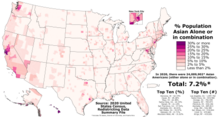
Asian Americans
Americans of Asian ancestry / From Wikipedia, the free encyclopedia
Dear Wikiwand AI, let's keep it short by simply answering these key questions:
Can you list the top facts and stats about Asian Americans?
Summarize this article for a 10 years old
Asian Americans are Americans of Asian ancestry (including naturalized Americans who are immigrants from specific regions in Asia and descendants of such immigrants).[9] Although this term had historically been used for all the indigenous peoples of the continent of Asia, the usage of the term "Asian" by the United States Census Bureau only includes people with origins or ancestry from the Far East, Southeast Asia, and the Indian subcontinent[10] and excludes people with ethnic origins in certain parts of Asia, including West Asia who are now categorized as Middle Eastern Americans.[11][12] The "Asian" census category includes people who indicate their race(s) on the census as "Asian" or reported entries such as "Chinese, Indian, Bangladeshi, Filipino, Vietnamese, Indonesian, Korean, Japanese, Pakistani, Malaysian, and Other Asian".[13] In 2020, Americans who identified as Asian alone (19,886,049) or in combination with other races (4,114,949) made up 7.2% of the U.S. population.[14]
Chinese, Indian, and Filipino Americans make up the largest share of the Asian American population with 5 million, 4.3 million, and 4 million people respectively. These numbers equal 23%, 20%, and 18% of the total Asian American population, or 1.5% and 1.2% of the total U.S. population.[15]
Although migrants from Asia have been in parts of the contemporary United States since the 17th century, large-scale immigration did not begin until the mid-19th century. Nativist immigration laws during the 1880s–1920s excluded various Asian groups, eventually prohibiting almost all Asian immigration to the continental United States. After immigration laws were reformed during the 1940s–1960s, abolishing national origins quotas, Asian immigration increased rapidly. Analyses of the 2010 census have shown that Asian Americans are the fastest-growing racial group in the United States.[16]
